- 408-924-7560
- mineta-institute@sjsu.edu
- Donate
Newsletter Fall 2013: Vol. 20, Issue 2
The Consortium hits its stride
Rod Diridon,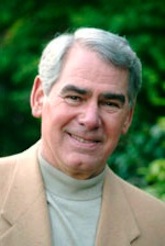 Executive Director, MNTRC
Executive Director, MNTRC
MNTRC is operating at full capacity, with 49 research projects in process, full and expanding academic programs, and 23 outreach activities conducted during the past year.
Multiple outreach events
While the research and education components are obvious and highly valued, the outreach may be even more important. The old adage comes to mind: “If a tree falls in the forest, and no one is there to hear it, does it make a sound?” Indeed, the MNTRC research does “make a sound.” The energetic MNTRC outreach effort systematically brings the new research to the attention of the transportation community, inviting potential users to discover and, ideally, incorporate the latest research findings.
The outreach events of the past year have been highlighted in prior newsletters. The following events are planned by the Mineta Transportation Institute, in some cases with participation from other MNTRC university members:
- September 30-October 2, 2013, Chicago, APTA Annual Meeting – MTI will host a session on Tuesday, October 1, addressing “Transit Connectivity for High-Speed Rail.”
- October 10-11, 2013, San Francisco, Shared-Use Mobility Summit - MTI is a co-sponsor of this event addressing the current state of shared-use vehicles, the industry opportunities, and the obstacles to market expansion.
- October 22-24, 2013, Washington DC, Transit Communications - MTI is a sponsor and will present during an expert panel addressing “Using Digital Media to Increase Transit Ridership.”
- October 24-25, 2013, Washington DC, Podcar City 7: Innovations in Public Transportation - MTI is a sponsor, and it will present a panel on funding and finance for new Automated Transit Network (ATN) systems. These are small cars on guideways that can help reduce traffic congestion and emissions.
- March 13-15, 2014, San Jose CA, 55th Annual Transportation Research Forum - MTI is co-sponsoring this industry-wide conference, which will present more than 100 papers in 25 sessions.
- March 28, 2014, San Jose CA, Annual Green Industry Hall of Fame - MTI is co-sponsoring this conference, which promotes green practices in transportation and lifestyles, and honors those who provide exemplary green leadership. The day-long session will be followed by an awards banquet.
- Date TBA, Nationwide, Garrett Morgan Sustainable Transportation Competition - MTI established this competition, now in its 14th year. Middle school students create a sustainable transportation project and compete by live videoconference to determine a winner.
More outreach activities will be planned as the year progresses and will be highlighted in the next newsletter.
Congratulations to Leo Hanifin
Congratulations to MNTRC director Leo Hanifin, dean of the College of Engineering and Science at the University of Detroit Mercy, who has been appointed to the Regional Transit Authority of Southeast Michigan’s Citizens Advisory Committee (CAC).
The confirming letter noted, “It is with great enthusiasm about your skill set, as well as your commitment to improving public transportation in our region, that we write to invite you to serve a two year term on the CAC, starting immediately.”
As a member of the CAC, Dr. Hanifin will advise the RTA on transit issues, suggest transit service improvements, and advocate greater funding for public transportation.
MNTRC is proud to have him as its professional colleague. Please join MNTRC in applauding this accomplishment.
Board Profile: Diane Woodend Jones
Donna Maurillo, MNTRC Director of Communications

Diane Woodend Jones, Chairman of the Board, Lea+Elliott, Inc.
A recent addition to the MNTRC Board, Diane Woodend Jones is the Chairman of the Board for Lea+Elliott, Inc., a transportation consulting company with a dozen US offices and an international practice. As a principal in the company’s Dallas/Fort Worth office, she is also involved in the management of the company’s central region.
MNTRC chose Diane in part for her transportation and board of directors experience. She has served in operations management as well as on Lea+Elliott’s board for more than a decade. During her board service, Diane spearheaded and continues to lead the firm’s strategic planning initiatives. In part due to her efforts, the company has grown into an international practice.
She also brings a great deal of insight about many facets of mobility. Diane began her career at DFW International Airport and joined Lea+Elliott in 1989. During the past 30 years, she has managed many large infrastructure projects in transportation and aviation. Her professional experience includes architecture; airport, urban, and transportation planning; project development; transportation system integration; procurement; program management; contract compliance; and project oversight.
As a registered architect and certified planner with an MBA degree, Diane is very comfortable leading and participating in multi-disciplined professional environments. When she began her career at Lea+Elliott, it quickly became evident that the blend of her ability to lead complex projects and relate well to other disciplines was a very effective combination.
Diane strongly advocates the benefits that women’s insight, perspective and contributions bring to transportation industry leadership, and as such, she is proud to serve on the Women’s Transportation Seminar (WTS) International Board of Directors. As a National Association of Corporate Directors Governance Fellow, Diane is committed to boardroom excellence. She maintains an ongoing engagement in the director community with a focus on best practices.
Diane is also an active member in other organizations, including the American Planning Association, the American Institute of Architects, the Texas Society of Architects, the U.S. Green Building Council, and the American Public Transportation Association. She is certified as a LEED® Accredited Professional, meaning that she is regarded for her Leadership in Energy & Environmental Design within the green building movement.
Diane has a Bachelor of Science in architecture and environmental design from the University of Texas and a Masters in Business Administration from Southern Methodist University’s Cox School of Business.
“The Mineta Transportation Institute is the foremost leader in significant and relevant research related to US transportation policy,” Diane said. “I am honored to be selected as a Trustee and to have the opportunity to serve with leading industry experts in providing important and meaningful guidance to MNTRC’s future research.”
She noted that Lea+Elliott’s focus has been on leading-edge transit technologies and project delivery since its inception 40 years ago. “As such,” she said, “I come to the MNTRC Board with many years of experience in alternative project delivery and automated transit technologies. Throughout my career, I have had an interest in managing the complexities of integrating transportation systems in physically, politically and commercially dynamic environments. The possibilities related to advancing our public policy and practices to support the continued development and sustenance of our transportation systems are vast. The MNTRC’s research plays a significant role in laying the groundwork for realizing those possibilities.”
Li-Ion battery recycling makes progress
Charles Standridge, PhD, Professor and Assistant Dean
GVSU NEWS – Professor Lindsay Corneal and Master of Science in Engineering student Eric Li of the School of Engineering of Grand Valley State University (GVSU) have been working on recycling processes for lithium-ion batteries that have reached the end of useful life in a vehicle. This work is in keeping with the GVSU core value of sustainability – meeting current needs without compromising the needs and resources of future generations. It has been performed as part of our partnership with Sybesma’s Electronics in Holland MI.
Thus the purpose of recycling lithium-ion batteries is to extract and collect as much valuable material from the spent cells as possible, in an economical and environmentally friendly way. Recycling process development focused on lithium iron phosphate (LiFePO4) batteries for which no previous studies have been reported.
Acid leaching method proved successful
The particular LiFePO4 cell that interests the researchers consists of a graphite-coated copper foil (anode), LiFePO4-coated aluminum foil (cathode), two separator layers, liquid electrolyte, plastic components, and aluminum shells. At issue is how to efficiently separate the coating from the foil and to extract the raw material. Dismantling and alternative material extraction procedures were developed and tested. The latter involve using either acid leaching, N-Methyl-2-pyrrolidone (NMP) separation, or acidic gas to separate the materials on both electrodes of the battery.
Results showed that the acid leaching method is effective in separating components of both electrodes in a short time at an elevated temperature. The graphite coating completely detached from the copper foil in 0.5 mol/L sulfuric acid (H2SO4) solution in one minute at 40°C (104°F), and 95% of the LiFePO4 coating detached from the aluminum foil in 0.5 mol/L nitric acid (HNO3) solution in one minute at 50°C (122°F).
Researchers will continue testing
N-Methyl-2-pyrrolidone (NMP) was also used on the attempt to separate the materials in electrodes, but the results were unsuccessful. The researchers studied copper-graphite self-separation by acidic gas, and the application with NO2 was proven successful. However, more precise measurement on the effective gas concentration is recommended for practical applications in the future.
The research team will continue developing and refining the recycling process throughout the fall of 2013.
NTSI stimulates high school students
Errol Noel, PhD, Director, Howard University Transportation Research Center
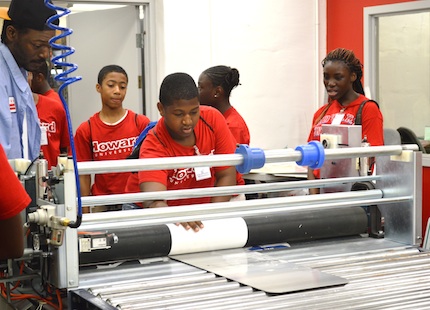
Students try their skills in the District DOT sign shop.
HOWARD UNIVERSITY NEWS – Howard University has been hosting the National Summer Transportation Institute (NSTI) on campus in Washington DC since 1998. More than 300 students have participated. The objective is to expose high school students to the many opportunities available in transportation and to inspire them to pursue transportation professions through a variety of educational, motivational, recreational, and cultural activities.
The Federal Highway Administration (FHWA) and the District Department of Transportation (DDOT) fund the program. The financial support provides speakers, field trips, classroom materials, mentors and lunch for the program at no cost to the participants.
College students serve as mentors
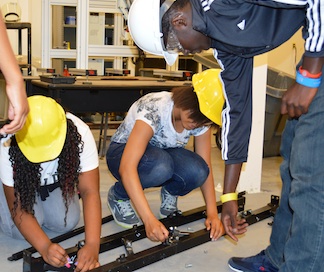
At Howard, students learn how a bridge is constructed.
Each year, the Howard University Transportation Research Team selects 25-35 students to participate in a four-week, non-residential program on campus. Applications are accepted from students in junior and senior high school. This year’s program consisted of 26 students from the District of Columbia, Maryland, and Virginia region. The Howard staff is supplemented by the addition of 4–6 college students to provide administrative support, manage logistics, and most important, to be mentors for the students during the summer tenure. The 2013 team of mentors had backgrounds in mechanical engineering (PhD applicant), and undergraduate majors in civil engineering, electrical engineering, biology, and accounting.
The students visited Maryland State Highway Administration (MSHA), DDOT, Turner Fairbank Highway Research Center, (FHRC), Virginia Department of Transportation (VDOT), and The Smithsonian National Air and Space Museum. They also took a multimodal trip to the Baltimore Aquarium.
Professional development included in program
The students had professional development and technical classroom and lab sessions. Topics covered Excel, Word, PowerPoint, web development, journal writing, self-esteem and peer pressure, formal dining etiquette, FHWA transportation careers, career development, resume writing, and interviewing techniques. They also built a steel bridge in the lab.
At the end of the program, a ceremony acknowledged participant completion and provided an opportunity for the students to do a presentation on their STI experience. This year, the student teams gave presentations on DDOT, MSHA, TFHRC, FHWA, and WMATA. The program audience consisted of parents, staff members from DDOT, FHWA, the Office of Youth Empowerment Child and Family Services, and the Howard support team. Students received various team and individual awards, along with certificates of completion.
Measuring benefits of transit-oriented development (TOD)
Robert B. Noland, PhD, Director, Voorhees Transportation Center
RUTGERS NEWS – A team of researchers at Alan M. Voorhees Transportation Center (VTC) at Rutgers University led by Prof. Robert Noland, PhD, will soon be completing work on a two-year study “Measuring the Benefits of Transit-Oriented Development.” This study provides an overview of the beneficial impacts of transit-oriented development (TOD) – compact, mixed-use pedestrian land uses within walking distance of transit stations. These benefits can lead to more vibrant and healthier communities and provide personal benefits to those who wish to live in TODs and near stations.
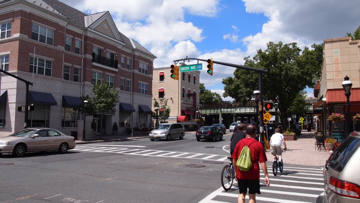
Cranford (NJ) Crossing, with rentals above ground-floor retail. Shown are TOD (left), with Cranford Station behind buildings on the right.
Source: Alan M. Voorhees Transportation Center.
Goal to decrease automobile use
A major goal of TOD is to direct land development to where public transit and infrastructure already exist. The expectation is that transit ridership will increase and auto use will decrease as the convenience of transit leads it to become the mode of choice. Increased transit ridership and decreased auto use are generally accepted as public benefits. They result in reduced air pollution, greenhouse gas emissions, traffic congestion and accidents, as well as increased physical activity if walking trips increase with associated health benefits. Other benefits that may accrue to individuals, households, and communities include a more stable economic base and a better sense of community.
1,629 households surveyed
The objective was to document and assess the benefits gained by implementing a TOD strategy through both qualitative and quantitative approaches. To do so, the team collected and examined data from key informant interviews, focus groups of those living near four stations, and a mail and online survey of 1,629 households near eight stations in New Jersey. Additionally. researchers conducted case studies of three communities that have adopted a TOD strategy.
TOD findings positive
Professionals and decision makers in New Jersey strongly support TODs and see this as a way to rejuvenate communities and benefit the residents of those communities. Those whom the team interviewed also support TOD.
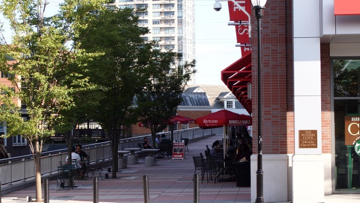
Gateway Center, with condos, rentals, and office above the ground-floor retail. Shown is the pedestrian bridge connecting the TOD to the New Brunswick (NJ) Train Station.
Source: Alan M. Voorhees Transportation Center.
Focus group participants offered broad support for development near stations. These residents appreciated the rejuvenation that TOD has brought their communities, the access to transit, and the ability to walk in their downtown areas. They held mixed opinions about the retail component of some projects because they thought that most of the retail was focused on entertainment and not on basic needs. They also were concerned about increased traffic endangering pedestrians.
Researchers found that residents living within a half-mile of a station are more likely to walk and to take public transit more frequently than those who live from one-half to two miles from a station. They also drive less. This finding holds when controlling for various attitudes toward one’s neighborhood, demographic factors such as income and age, vehicle ownership, how long one has lived in their current residence, and features of the built environment.
Health improved; property values increased
Results show that being close to a station enhances residential property values, while controlling for other factors that influence valuations. TOD can also be used as a way to increase the diversity of housing choices in a community as smaller units, or more affordable units, mitigate the impact of any increase in property values.
Based on self-reported health information, researchers found that those living near stations reported fewer incidences of a heart condition or diabetes than those living further from the station. Both of these conditions are associated with lack of physical activity.
Casualties from traffic crashes are less frequent near rail or light-rail stations. Pedestrian casualties are less frequent in areas with more population density. Bicycle casualties are higher near stations, perhaps due to more bicycling activity.
“Travel time” cost can be higher with transit
Out-of-pocket expenses associated with using transit are less than those associated with driving. Travel time costs, however, are higher for transit except for those boarding in lower-income communities. This is due to a methodology that bases the value of time on average wages. Total costs of using transit are lower for those boarding at Broad St (Newark) and Plainfield and also at New Brunswick.
Researchers analyzed the impact of shifting population to be closer to the station using a regional travel demand model. If more people lived near transit stations, regional congestion would be reduced, and more people would take transit.
San Jose State University News
MTI awards 15 new research grants
Karen Philbrick, PhD, Director of Research
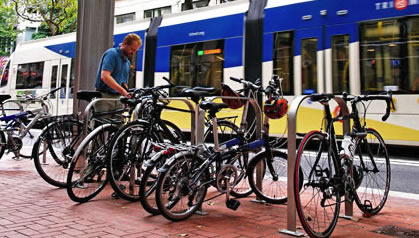
One funded study will focus on cyclers’ access to transit.
In response to the 2013 Request for Proposals (RFP), MTI received 40 high-quality transit-oriented submissions. These proposals were sent to MTI’s Research Associate Policy Oversight Committee (RAPOC), which is composed of the seven San Jose State University deans and department heads (or their designees) of the academic units with which MTI is associated, as well as to designated research liaisons from Caltrans and USDOT FTA.
After reviewing the proposals individually using a standardized rating form, RAPOC met in June and, with input from the research liaisons, identified the priority projects that can be funded within the research budget available to MTI. Priority of the research to Caltrans and FTA is paramount, though research project design, and quality of and prior performance of the RA team, also have a bearing on project selection.
Read the details of these 15 newly selected research projects.
MTI research makes positive impact
MTI has a rich history of conducting research with significant impact and is confident that the full slate of new research projects will yield similar results. Since 2010, MTI research results have yielded 263 academic and professional presentations and 138 publications, including MTI research monographs, peer-reviewed journal articles, and book chapters.
Selected examples of other research projects with impact include:
- MTI funded research on the applied principles of social learning to develop a transit training video for residents of the Rossmoor senior adult community in California. This video won TRB’s “Communicating with John and Jane Q. Public” competition.
- MTI researchers developed a Bus Rapid Transit (BRT) Guidebook that became the Caltrans Division of Mass Transportation’s BRT handbook.
- MTI sponsored research that developed a Tribal Corridor Management Plan for Caltrans.
- In 2011 the US Department of Homeland Security awarded MTI’s National Transportation Safety and Security Center the Science and Technology Directorate’s “Impact Award.” MTI transitioned research and analytical findings into training for TSA Explosive Operators deployed in mass transit, passenger rail, and freight rail environments.
- MTI researchers delivered an after-action evaluation of Operation Iron Horse for the Silicon Valley regional commuter rail systems. Sponsored by the regional Urban Areas Security Initiative, the results are being integrated into first responders’ procedures.
- MTI research associates received the “TRB Second Annual Outstanding Research Paper in Public Transportation Award” in 2011 for MTI’s Greenhouse Gas Emission Impacts of Carsharing in North America.
MTI looks forward to aggressively pursuing this new research agenda.
Transportation Safety & Security
Prepare for disaster as climates change
Frances Edwards, PhD, Deputy Director, MTI National Transportation Safety and Security Center
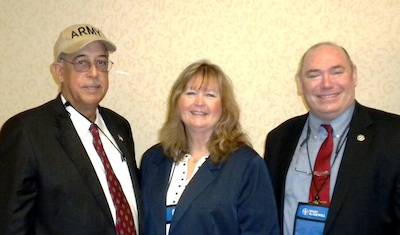
Dr. Frances Edwards met in New Orleans with Gen. Russell Honore and Dr. John Kiefer of the University of New Orleans.
As world populations are preparing for climate change, they also must prepare for the inevitable disasters that are predicted to go along with it. These include hurricanes, “super storms,” floods, fires, and even new diseases as tropical pathogens move northward with warming temperatures.
MTI has been very involved in the kinds of conferences addressing those issues. Here is a sample of the Institute’s activities so far this year.
Handbook forms the basis for presentation
At the American Society for Public Administration (ASPA) conference in New Orleans a few months ago, Frances Edwards, PhD, was pleased to present a paper on “Transportation and Climate Change,” while MTI Research Associate Daniel Goodrich discussed “The Role of the Seismic Safety Commission in Disaster Mitigation.”
In addition, Dr. Edwards presented a report on the Hurricane Katrina Task Force. This was based on their research with the Federal Emergency Management Agency (FEMA) and the US Department of Homeland Security (DHS), which MTI will publish as a handbook later this year.
Dr. Edwards also represented MTI in a panel discussion on that topic, along with General Russell Honoré of the Louisiana National Guard, which managed successful aspects of Hurricane Katrina response. Also on that panel were representatives of the City of New Orleans, St. Tammany Parish, and the Louisiana Office of Emergency Services.
Disaster planning must include transportation
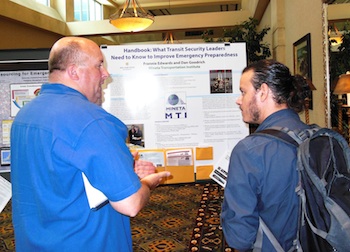
MTI Research Associate Dan Goodrich discusses emergency planning with student.
While they were in the city, Drs. Edwards and Goodrich also exhibited at the Disaster Resistant University conference, hosted by the University of New Orleans. As keynote speaker, Dr. Edwards discussed MTI’s 2009 research on The Role of Transportation in Campus Emergency Planning.
In May, the two presented "Emergency Management and the Role of Transportation" at Metropolitan College in New York City. Their student-driven topics included evacuation plans, the role of mass transit in preventing the spread of communicable diseases, and the use of social media for emergency notifications in a diverse community. Thirty students and three faculty members participated in the two-hour class.
Drs. Edwards and Goodrich represented MTI again at the 38th Annual Natural Hazards Research and Applications Workshop in Broomfield, CO, this summer. Their poster summarized MTI’s current research on the need for an exercise handbook for the transportation sector. They conducted a survey with response cards, as well as talking to expert practitioners and researchers, who uniformly supported a project management-based approach using checklists for guidance.
Education
MSTM alumni gain career advancement
Peter Haas, PhD, Director, MTI Education Programs
What happens when transportation professionals take the Mineta Transportation Institute’s Master of Science in Transportation Management? They move ahead in their careers. The program offers a complete range of relevant courses, such as disaster management, legal and legislative issues, leadership, funding and finance, security management, and much more. In this issue, we highlight two recent milestones.
Matthew Jue is published
Alumnus Matthew Jue (MSTM, 2009), traffic engineer for the City of Campbell CA, co-authored an article, “Detection Range of Optical Emergency Vehicle Preemption System under Typical System Maintenance Conditions," in ITE (June 20, 2013). Optical Emergency Vehicle Preemption (EVP) systems are widely used to help first responders pass safely through signalized intersections.
The article examines the performance of an optical EVP installation under typical field conditions. In simpler terms, it examines the detection range of an optical EVP system vs. the detection range often quoted by EVP manufacturers. The researchers found that the field-measured detection range was only 18.4 percent of the 2,500-foot range most often quoted by manufacturers' sales representatives. That’s a significant difference!
Joe Rouse earns a promotion
Alumnus Joseph (Joe) Rouse has just been promoted to become Caltrans Managed Lanes Manager in the Division of Traffic Operations. In his new role, he will establish a Managed Lane Development Initiative by collaborating with headquarter divisions, the districts, and external transportation partners. This will significantly increase the pace of new managed lanes projects.
Joe will ensure statewide consistency on implementing managed lane policies and guidelines, along with providing technical support to the districts. Lastly, he will be working on the feasibility of Caltrans developing managed lanes systems and tolling authority.
He has been with Caltrans since 1997, first as a student assistant at TransLab and the Division of Transportation System Information. Since 2007, he has been the statewide functional manager (senior transportation engineer) for HOV lane operations. For his MSTM, Joe’s capstone paper addressed possible legislative changes to expand the use of tolling in California.
Nina Rohlich lands in Seattle
It was a new position with Seattle DOT that attracted alumna Nina Rohlich, who previously had been working with Caltrans. As the consultant contracting manager, she oversees consultant contracts for the agency, including managing consultant procurement processes (RFP/RFQs). She also is developing and implementing departmental policies and procedures relating to contracts, she is a liaison with other departments and agencies, consultants, and project managers so everyone can exchange information, coordinate work, and negotiate agreements or contracts.
“It’s all about the contracts,” Nina says. “I oversee invoice reviews to ensure contract compliance and adherence to city policies. And I’m also training PMs and internal staff on the consultant contracting process and requirements, in addition to I supervising consultant contracting staff.”
Information & Technology Transfer
MTI group goes into the bridge
Donna Maurillo, MSTM, Director, Communications & Technology Transfer
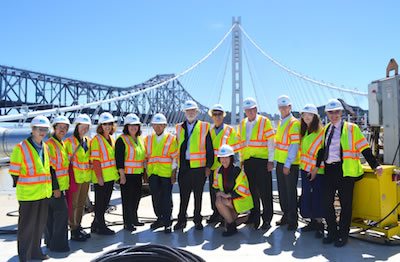
The MTI group was the only one to make the complete tour inside the understructure of the new Bay Bridge eastern span.
Millions of people will be driving over the new eastern span of the Oakland Bay Bridge, but how many will get to see the inside? On June 21, MTI hosted a group to visit the bridge during construction, and Caltrans tour guides had a surprise. The tour went into the tunnel-like structure beneath the roadway, and this was the only “outsider” group to do so.
Only the stairs themselves separated the group from the watery San Francisco Bay, as they descended to the underside of the bridge and into its dark interior. The visitors – including MNTRC Trustees such as Secretary Norman Mineta, Mort Downey, Ann Canby, Flora Castillo, and others – walked more than a mile through portholes, along catwalks, down ladders, and into cave-like areas.
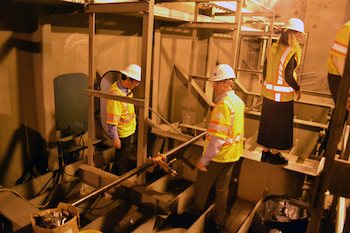
Tour participants step lightly inside the Bay Bridge as they get a lesson in construction.
Caltrans employee Paul Jefferson, who led the tour, took it all in stride, having gone through the structure many times. “But I have to give you credit for making it all the way to the end,” he said. At one point, the tour moved into a cramped space to view the area where the suspension cables are tied down.
It was notable that, even in the area out of public view, work crews were careful to sweep up and carry out even the smallest amounts of construction debris.
After emerging onto the roadway and into the sunlight again, there were a lot of comparisons to “feeling like gophers.” Topside, the group observed as the new roadway surface was coated before returning to the visitor center.
The new eastern span opened Labor Day weekend. It will take three years to demolish the old bridge—including the section rebuilt after the 1989 Loma Prieta Earthquake.
MTI co-sponsors industry workshops
As a way to help promote the importance of public transportation, MTI has sponsored or co-sponsored a growing number of conferences and industry meetings. All of them have featured nationally or internationally prominent speakers, thanks to MTI’s deep roots within the transportation professions.
Co-sponsorships also give MTI a chance to maximize the value of its grants while collaborating with leading transportation partners.
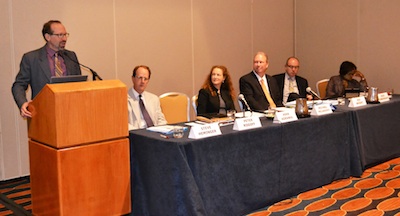
FRA Administrator Peter Rogoff addresses MTI’s APTA Rail workshop audience. Panelists included Steve Heminger, Dr. Asha Agrawal, Michael Melaniphy, Bud Wright, and Julie Cunningham.
MTI hosts panel at APTA rail Philadelphia
In June, the Mineta Transportation Institute sponsored “Catching Up with the Rest of the World,” a half-day Mineta National Policy Summit on Transportation Finance at APTA Rail in Philadelphia. This workshop featured a keynote by Federal Transit Administrator Peter Rogoff. Panel moderator was San Francisco Bay Area Metropolitan Transportation Commission Director Steve Heminger, with a panel composed of COMTO CEO Julie Cunningham; APTA CEO Michael Melaniphy; Administrator Rogoff; and AASHTO CEO Bud Wright. MTI’s National Transportation Finance Center Director Dr. Asha Weinstein Agrawal presented the results of a national transportation funding survey, along with four years of trends.
Also at APTA Rail, MTI co-sponsored a workshop on “Seamless Intermodal Transfers.” It addressed how agencies create seamless transfers and connections among modes, and how cities partner with the private sector to deliver passengers to their final destinations. The panel explored whether existing systems will simply pick up passengers at the station, or whether the routes and schedules will require adaptations. The workshop also previewed the MTI study on how locating high-speed rail stations can best work with other public transportation systems.
MTI maintains direct role in CUTC
Memphis was MTI’s destination from June 10-13 for the Council of University Transportation Centers (CUTC) Summer Meeting. As a leading member of CUTC, MTI participated in strategy sessions, workshops, committee discussions, and other business relevant to the members’ transportation research activities. MNTRC/MTI Deputy Director Karen Philbrick was elected to the prestigious CUTC Executive Committee, while Communications Director Donna Maurillo will lead a team to create a college-level work experience guidebook for CUTC’s Workforce Development Committee.
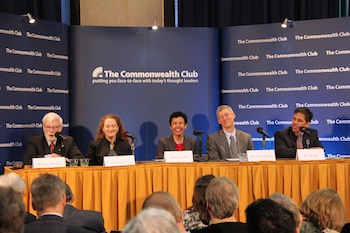
Panelists at the Mineta Policy Summit on Finance include, from left, Mort Downey, Dr. Asha Agrawal, Flora Castillo, Malcolm Dougherty, and Jeff Morales. The program was re-broadcast on NPR.
Leaders gather to discuss public sector innovation
Closer to home, Norman Y. Mineta Transportation Policy Summit on Transportation Finance was held in San Francisco at the Commonwealth Club of California. A keynote was given by US DOT General Counsel Kathryn Thomson, who was introduced by Secretary Norman Mineta. A panel discussion included Dr. Asha Agrawal, Director of MT’s National Transportation Finance Center; former Deputy Transportation Secretary Mortimer Downey; California Department of Transportation Director Malcolm Dougherty; California High-Speed Rail Authority CEO Jeff Morales; and APTA Chair and New Jersey Transit Board Member Flora Castillo. Dr. Agrawal presented the latest research results from a national survey polling Americans about transportation taxes and fees.
Finally, at the end of June, MTI co-sponsored the Public Sector Innovation Workshop, along with the City of San Jose, the Aerospace Corporation, the National Academy of Public Administration. This was a select gathering of industry, government agency, academic, and community leaders. Discussions centered on how to accelerate public-sector technological innovation in transportation, energy, the environment, and many other important community needs while minimizing the financial risk. Automated Transit Networks (ATNs), personal transit systems, were used as a model.
Summer camp engages future transportation leaders
Hualiang “Harry” Teng, PhD, Director, Railroad, High Speed Rail, and Transit Initiative
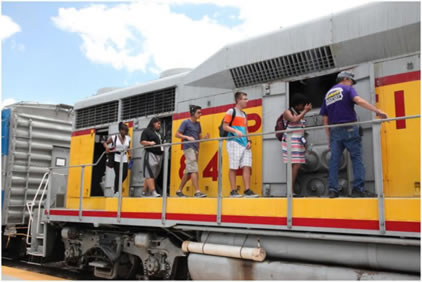
Summer campers tour Nevada railroad museum.
UNLV NEWS – The University of Nevada Las Vegas Transportation Engineering Summer Camp was part of the two-week camp held on the Reno (UNR) and Las Vegas (UNLV) campuses. The program recruited 11 boys and 9 girls. During their week at UNR, they took lectures on traffic engineering and transportation planning, and they visited local airport and highway facilities.
The activities at UNLV covered many modes of transportation, including highway, public transportation, trucks, railroad, monorail, and airport. But first, the students were treated to a VIP tour of Hoover Dam, the biggest dam in the world at the time of its construction. They were amazed at the magnitude of construction and engineering work. As part of the tour, they also saw the new Hoover Dam bridge, a major highway connection between Arizona and Nevada, making possible the economic expansion from Las Vegas into Arizona.
Talks from transportation professionals
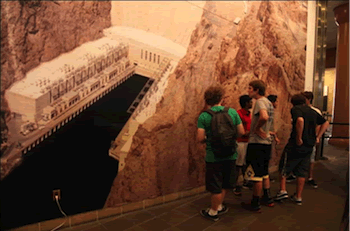
Students given VIP tour of Hoover Dam and the new Hoover Dam bridge.
The next day, the students rode the Regional Transportation Commission (RTC) bus to RTC, where the resident professionals gave a great presentation. The students visited other sites, including a major public transportation terminal in downtown Las Vegas, a hub that has state-of-art facilities for buses and bicycles. They also visited the Freeway and Arterials System of Transportation (FAST) that monitors and controls traffic for the Las Vegas Metropolitan area.
On the third day, professionals from the Nevada Department of Transportation (NDOT) gave presentations on their regular duty and current project. They discussed why safety is important to everyone, and how I-11 is important to the economic development in Nevada. The students also were taken to the famous Las Vegas Monorail, where they observed operation, maintenance, and development.
From there, the group visited Con-Way Logistics, one of the most successful trucking companies in the nation. Here, they learned about the complex operations involved in moving commodities efficiently from place to place and how important trucking is to the nation’s economy.
Behind-the-scenes transit tours
The fourth day, the students visited a Zappos.com project, where they learned how a company can be a major driving force to revive a downtown in which transportation is a major component. The group stopped at the UNLV architecture school for a historical perspective of the connection between transportation and land use.
These tours were followed by presentations, one on multi-culture in engineering and health, and another on public works, including transportation engineering in the cities of Las Vegas and North Las Vegas. From these presentations, students learned about possible career paths.
For the fifth day, students had a tour of the Las Vegas airport, the seventh busiest airport in the nation. This included a tour of the airfield, where they learned about airport operation. The most interesting part of the tour was in the new terminal, where the new design concepts were presented, coupled with new airport technologies. After the tour, UNLV researchers presented their research results in an unmanned flying vehicle, driver simulator, and image processing for traffic. The students demonstrated tremendous passion on these new developments.
Transportation careers pique interest
Finally, students gave presentations about their solutions for transportation problems, such as congestion and safety, which they based on their experience in the two-week camp. Transportation professionals judged those presentations and gave awards. The general manager of the RTC discussed the contribution of transportation profession to the local and national community, leading the students to expect a successful career in transportation engineering.
Biodiesel reduces particulate matter for buses
Ashok Kumar, PhD, Chair, Department of Civil Engineering
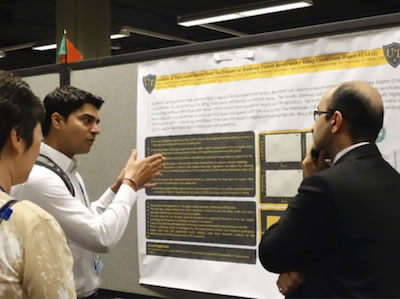
Hamid Omidvarborna (right) listens to a visitor discuss his poster at the AWMA 106th Annual conference during the Technical Poster session.
UNIVERSITY OF TOLEDO NEWS – In the past decade, biodiesel has become more prominent as an alternative renewable fuel to replace conventional fossil fuels in transportation. The University of Toledo (UT) had played a valuable role in conducting research related to biodiesel emissions from transit buses during the past eight years. Today, UT’s focus has shifted to examining the “Combustion Chemistry of Biodiesel for Use in Urban Transport Buses” under a research grant from the US Department of Transportation to the Mineta National Transit Research Consortium.
The project is directed by Dr. Ashok Kumar, Phd, Department of Civil Engineering, and Dong-Shik Kim, PhD, Department of Chemical & Environmental Engineering. Mr. Hamid Omidvarborna and Mr. Sudheer Kumar Kuppili are participating for their PhD and MS works, respectively. The two students presented individual posters at the Air and Waste Management Association’s (AWMA) 106th annual conference and exhibition in Chicago this past June 25-28.
Mr. Omidvarborna presented a technical poster, Analysis of Particulate Matter from the Exhaust of Biodiesel Transit Buses under Idling Conditions. The researchers performed idling tests on transit buses running on biodiesel. Meanwhile, they collected particulate matter (PM) from the tail pipe emissions.
New transit buses deliver positive net effect
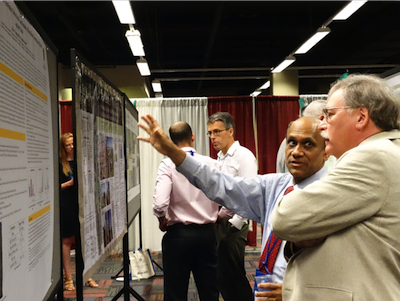
Dr. Ashok Kumar explains a technical poster to a visitor at the AWMA 106th Annual Conference, Technical Poster session.
The results showed that PM emissions significantly decreased when using a biodiesel blend fuel, and that new transit buses had a positive impact on PM reduction whether their engines were running hot or cold. Updated results depicted that the maximum PM concentrations for ten different buses under hot and cold idling conditions were 2.77 µg/m3 and 5.59 µg/m3, respectively.
Among the more than 12 elements considered for elemental analyses, calcium, iron, and sodium dominated (77-85 percent by weight). Organic carbon to elemental carbon ratio (OC/EC) analyses indicated that higher OC was emitted during cold idling conditions (>%80) than in hot idling conditions (>%65). Furthermore, OC/EC ratio was higher in new buses with catalytic convertors (9.57-13.37) than in old buses without converters (1.85-4.55). Source-receptor analysis using positive matrix factorization showed that four sources – fuel, oil and lubricant, engine parts, and ambient air – contributed heavily to PM generation in the exhaust.
Mr. Kuppili presented a student poster – A Patent Review on Biofuels – that discussed various patents issued worldwide in the past few years. These patents were related to biofuel production methodologies, fuel properties enhancement, feedstock variations, and integrated biofuel production facilities that lead to the production of efficient and surplus biofuel with environmental friendly production and usage.
Relevant patent registrations on the rise
An increase in the number of new patent registrations was due to an increase in the number of researchers associated with biodiesel and biofuel production technologies in the past decade. New methods such as using nanoparticles and ultrasonic standing wave systems were established for extracting lipids from algae. Meanwhile, catalytic hydro-thermolysis, non-faradaic electrochemical modification of catalytic activity effect and combination esterification, trans-esterification, alcoholysis, hydrolysis, and fermentation for production of biofuel and enhancing fuel properties by functionalizing esters using epoxy esters with Chloroperoxybenzoic acid as catalyst.
Nearly 3 billion tons of biomass is required in 2050 to meet the envisioned 27 percent biofuel share in world transport fuel consumption. For example, Brazil and the USA met 23 percent and 10 percent of their road transport fuel demand through biofuel in 2011.
More research should help improve results
Biodiesel produced from oils had good fuel purity in combination with higher efficiency in the conversion rate. However, it appears that more research must be focused on using catalysts to enhance production efficiency. A more unified technology that can readily handle various feedstock types is necessary to develop an integrated system to manage different wastes.
In cases of the animal waste conversion to biofuels, the production efficiency of conversion to ethanol has not crossed 50 percent, while it is nearly 99 percent for biodiesel. So, for a trouble-free future for fuels, diverse feedstock should be identified and used, and advanced technologies that can process a variety of feedstock must be introduced. Of course, government and industry investments in biofuel are always encouraged.
-
Events
Media Coverage
| CalBike Report 12/23/2025: The Last Mile of 2025 - Mineta E-Bike Study Published |
| Scofflaw Manufacturers Could Be The Downfall of E-bikes |
| How EVs and Transit are Rewriting the Affordability Map for Homebuyers |
Contact Us
San José State University One Washington Square, San Jose, CA 95192 Phone: 408-924-7560 Email: mineta-institute@sjsu.edu





